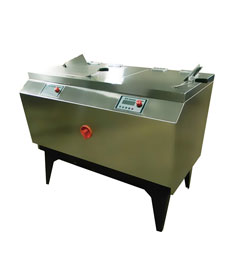What is a Launder-Ometer?
Durability refers to the ability to withstand damage or loading conditions. Durability is used to examine an application's durability capabilities. Durability testing, also known as performance testing, examines a system's performance under stress/load conditions.
Durability testing is a method used to evaluate the ability of a product, material, or structure to withstand various environmental factors and operating conditions over a long period of time while maintaining its performance and functionality.
As specialized equipment for durability testing, the Double-Cylinder Launder-Ometer can simulate drop, shock, and vibration scenarios encountered in real-world use, accurately assessing a product's impact resistance and structural durability.
About Different Types of Durability Testing
Durability testing encompasses a variety of types to comprehensively evaluate a product's performance under diverse environmental and stress conditions. Temperature testing, primarily conducted in laboratories, relies on reliable testing machines to measure a material's behavior when exposed to extreme temperatures. High-temperature testing, typically at 1800°F, is achieved by placing the product in a high-temperature furnace and precisely regulating the temperature using a computer control system. Tensile testing involves securing the product to a test frame, gradually applying pressure, and simultaneously measuring strain using an extensometer. The resulting pressure and strain data are recorded in real time on a computer system, ultimately generating a test report. Corrosion testing addresses the risk of permanent damage to a product. Failure to pass this testing can lead to business losses, health and safety risks, reputational damage, and reduced revenue. Testing utilizes high-quality, corrosion-resistant high-pressure vessels, combined with electrochemical monitoring, 3D laser profiling, and scanning electron microscopy to ensure the product's corrosion resistance. Vibration testing, typically conducted in production halls or laboratories, relies on electrodynamic shakers or servo-hydraulic shakers. Hardware and software collaborate to measure and control vibration pressure, simulating the shock environments a product might encounter in actual use. Aging testing uses accelerated conditions to advance the aging process and quickly verify product limits. Typically, specific frequencies (such as two months, two years, or five years) are set in a laboratory environment to simulate long-term use conditions to predict product lifespan. The number of samples can be flexibly adjusted based on demand. Fatigue testing is used to assess product degradation over time. By repeatedly applying force until the product breaks, the test machine, as a benchtop device, can quickly simulate motion and replicate the fatigue process. Initially, cracks appear on the product surface. As the test continues, the cracks gradually deepen and expand, eventually leading to complete product failure, thereby determining the product's durability under intense conditions.
Testing Purpose
Evaluating Product Lifespan: By simulating various operating and environmental conditions encountered in actual product use, we predict how long a product will continue to operate under normal use. This provides data support for the product's design lifespan and helps manufacturers determine product warranty periods and maintenance cycles.
Testing Product Reliability: Detecting performance degradation, malfunctions, or failures over long-term use to assess product reliability and stability, ensuring safe and stable operation throughout the product's lifespan and reducing after-sales repair and recall costs.
Optimizing Product Design: Identifying weaknesses and potential issues in product durability provides a basis for design improvements and optimization, thereby enhancing product quality and competitiveness.
Test Types: Durability testing can be systematically categorized into three main types: mechanical durability testing, environmental durability testing, and electrical durability testing, depending on the test object and purpose. Mechanical durability testing focuses on a product's ability to withstand mechanical stress, including fatigue testing and wear testing. Fatigue testing simulates the repeated stress scenarios a product experiences in actual use by periodically applying loads or stresses, detecting failures such as fatigue cracks or fractures in metal materials and mechanical components under long-term cyclic loading. Wear testing simulates the friction between a product and another object, measuring the amount and rate of surface wear to assess the wear resistance of products such as automotive engine piston rings and mechanical transmission components. Environmental durability testing primarily examines a product's ability to adapt to the natural environment, encompassing weathering and corrosion testing. Weathering testing involves placing the product in simulated natural weather conditions (such as high and low temperatures, humidity, light, and rainfall) or artificial weathering test chambers, using accelerated aging testing to examine changes in the performance of materials such as plastics, rubber products, and coatings under long-term environmental factors. Corrosion testing targets corrosive environments such as humidity, acid, alkali, and salt, using salt spray testing and damp heat testing to assess the corrosion resistance of products such as automotive bodies, ship hulls, and metal pipes. Electrical durability testing focuses on the electrical characteristics of electronic products, including life testing and electrical stress testing: Life testing involves powering on electronic products or electrical equipment for a long time, monitoring changes in the electrical and thermal performance parameters of LED lights, power adapters, electronic components, etc. during long-term use, to evaluate their electrical life and reliability; electrical stress testing applies abnormal electrical stresses such as overvoltage and overcurrent to detect the product's electrical insulation performance and overload capacity, and then evaluate its durability and safety under the action of electrical stress.
Test Methods
Accelerated Life Testing: By increasing the test stress level, such as increasing load, temperature, and voltage, the product is caused to fail or degrade in a relatively short period of time, thereby quickly obtaining product lifespan data and reliability information.
Field Testing: The product is installed in the actual use environment and subjected to long-term field testing to directly obtain durability data under real-world conditions. This method provides the most accurate reflection of actual product usage, but the testing cycle is long and the cost is high.
Simulation Testing: Utilizing testing equipment and technology, the product is subjected to durability testing in a laboratory environment, simulating various operating conditions and environmental conditions encountered in actual use. For example, a vibration table is used to simulate the vibration environment experienced during transportation, and an environmental test chamber is used to simulate different climate conditions.
In summary, durability testing is an indispensable cornerstone in product development and quality assurance, enabling manufacturers to accurately assess the lifespan, reliability, and design robustness of their products in mechanical, environmental, and electrical fields. From accelerated life testing that accelerates reliability insights, to field testing that captures nuances of real-world performance, to simulation testing that replicates complex operating scenarios, these methods work together to ensure that products meet stringent durability standards. Among the many professional tools driving progress in this field, the dual-cylinder durability tester is a key instrument for evaluating the durability of structures under dynamic stress conditions, especially in simulated drop, shock, and vibration scenarios. By combining this type of advanced testing equipment with a systematic durability assessment framework, the industry can not only improve product competitiveness, but also increase confidence in product performance across different applications and life cycles.


